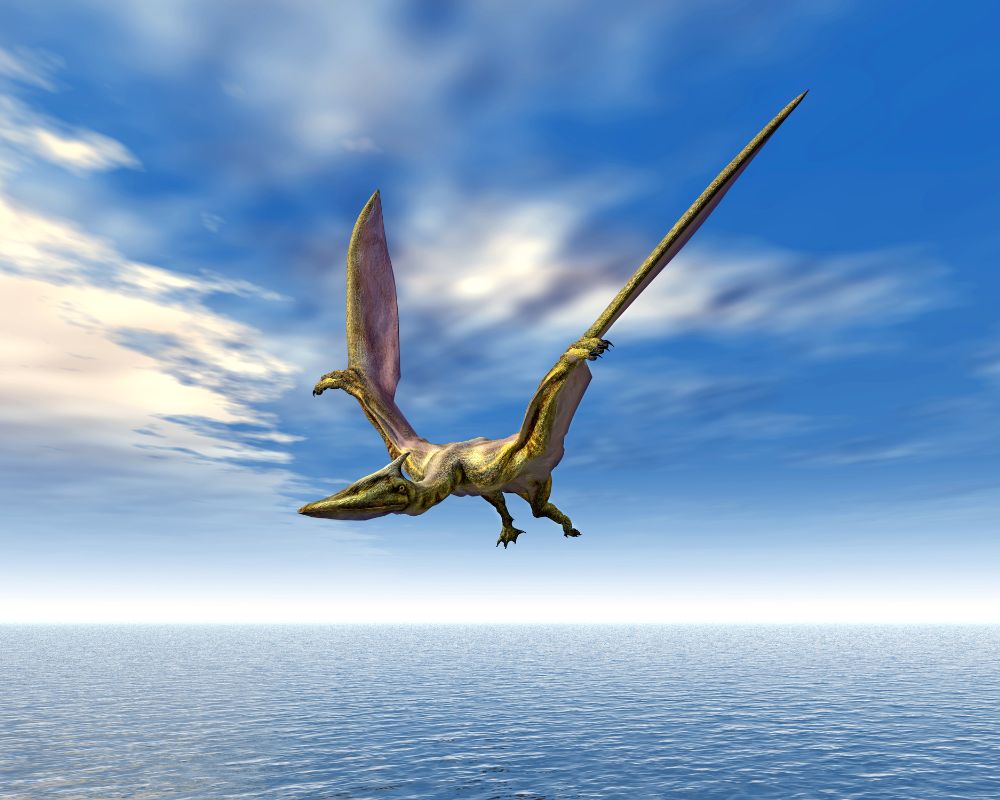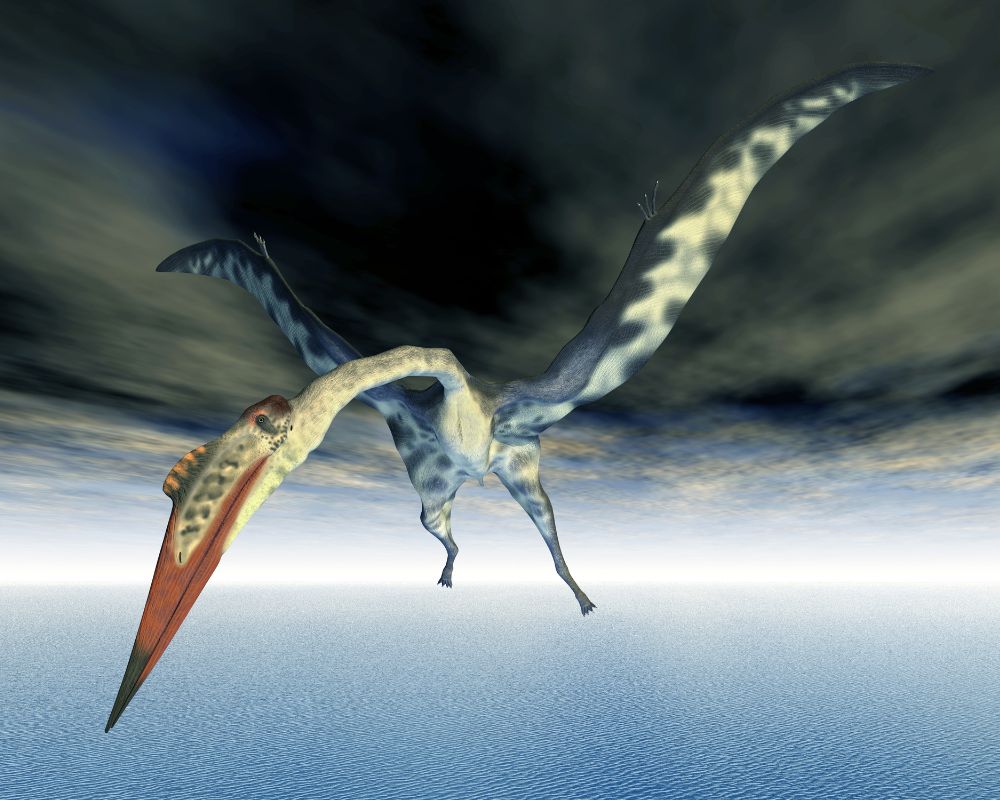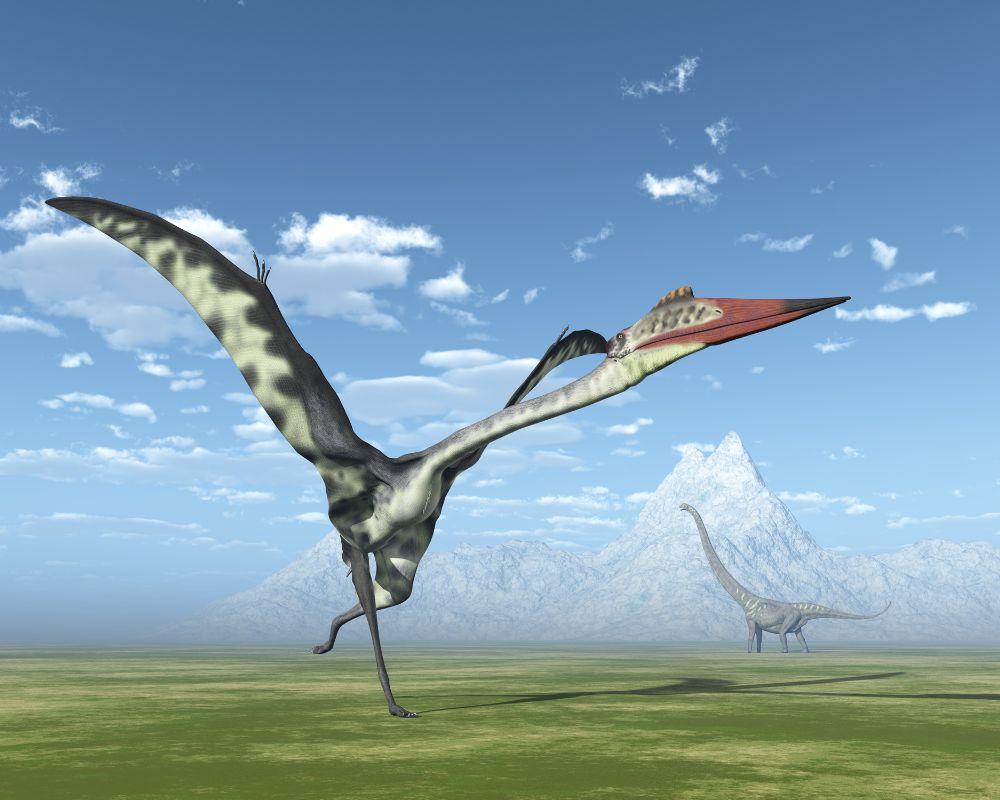The Quetzalcoatlus was one of the late Cretaceous’ largest pterosaurs and had no natural predators. While it was a huge dino, this coastline-loving dinosaur mainly ate fish and scavenged off dead dinos like a vulture.
Table of Contents
Some Quick Facts About the Quetzalcoatlus

| Name | Quetzalcoatlus northropi, “Feathered serpent god” |
| Type of dinosaur | Pterosauria |
| Territory | Coastal and marine areas, North America |
| Size | Very large, wingspan of 36 feet, 200-500 pounds |
| Color | Feathers were possibly brown, grey, and white |
| Interesting Characteristics | It was the largest flying creature ever to live, and some paleontologists believe it walked on its wings |
| Diet | Smaller dinosaurs and reptiles often scavenged off dead creatures |
| Major Threats | Large theropods, natural disasters |
The Quetzalcoatlus was a coastline-dwelling pterosaur of the Late Cretaceous that lived on the coastlines of North America. With a wingspan of almost 40 feet, it was one of the largest creatures to ever fly. With its mighty wings, it could lift its 500-pound body off the ground and reach up to 80 miles per hour.
What Does Quetzalcoatlus Mean?
“Quetzalcoatlus” is pronounced ket·suhl·kow·at·luhs. In Aztec literature, the god Quetzalcoatl was portrayed as a winged serpent, where Quetzalcoatlus earned its name.
The very first Quetzalcoatlus fossils came from the Maastrichtian Javelina Formation at Big Bend National Park, so its name pays tribute to the indigenous people of Texas. The sheer mass of this enormous pterosaur deserved a name fitting to its size, and Quetzalcoatlus was an excellent choice.
What Is The Quetzalcoatlus’s Wingspan?

The wingspan of the Quetzalcoatlus is between 33 and 36 feet, around the length of a modern school bus. Its massive wingspan made it not only the largest flying reptile of the Cretaceous period but one of the largest flying creatures ever to soar the skies of planet Earth!
Due to its massive size, paleontology believes that the Quetzalcoatlus only flew for short distances. It would catch a draft and soar through the air like an eagle.
How Strong Was The Quetzalcoatlus?
The Quetzalcoatlus had incredibly strong wings to launch it from the ground into the air, and it was an excellent flier. These giant pterosaurs of the late Cretaceous weighed around 500 pounds, about as much as a grand piano, and were as tall as a giraffe.
It needed strong wing bones and muscles to lift its massive weight off the ground! What’s even more impressive is that to fly, Quetzalcoatlus needed to jump off the ground to lift off. If it got a running start from the ground, its massive wings would have hit the ground, making it unable to fly.
Was The Quetzalcoatlus The Largest Creature Ever To Fly?
In the history of the world, the Quetzalcoatlus was the largest flying animal, not just the largest pterosaur. And while there were other winged and feathered dinosaurs of the late Cretaceous and Jurassic periods, most dinos didn’t fly.
Some could soar through the air if they caught a draft, but their flying abilities were limited, while others were skilled fliers like the Archaeopteryx. The Quetzalcoatlus could take off from the ground with a jump start and could reach speeds of up to 80 miles per hour!
The Quetzalcoatlus was so strong that it could travel almost 400 miles in a single day.
What Did The Quetzalcoatlus Eat?
Paleontologists aren’t sure what the Quetzalcoatlus ate, but they have a few theories. The Quetzalcoatlus hunted very similarly to modern-day storks. It has a long beak and toothless jaws that it used to snatch fish, crabs, and other marine life out of the water.
However, some believe that the Quetzalcoatlus was a scavenger, like a vulture, and ate the meat of carcasses of smaller species of dinosaurs and prehistoric lizards.
Did The Quetzalcoatlus Have Any Predators?

The Quetzalcoatlus spent a lot of time in the air, but it did have a few land predators when not in the air. Most Late Cretaceous dinos left the Quetzalcoatlus alone. Still, giant theropods like the Tyrannosaurus Rex or the Gigantosaurus sometimes tried to make a meal out of the Quetzalcoatlus, but it was unlikely.
The biggest threat to the Quetzalcoatlus was natural disasters. The Great Extinction Event that happened 65 million years ago led to the ultimate demise of the Quetzalcoatlus.
Could A Human Ride A Quetzalcoatlus?
No, a human couldn’t ride a Quetzalcoatlus for a few reasons. Given its massive size, its ability to take flight is a delicate balance. Even a little extra weight could throw off its balance and make it unable to take flight.
Furthermore, riding a wild Quetzalcoatlus would be like trying to mount a wild ostrich! If an ostrich doesn’t want you on its back, it will do everything possible to remove you. While we don’t know the temperament of the Quetzalcoatlus, it’s safe to assume that it would kick you off almost immediately!
Was There Anything Bigger Than Quetzalcoatlus?
There is one dino that could be even bigger than the Quetzalcoatlus: the Hatzegopteryx. The Hatzegopteryx is a bit of a mystery to paleontologists since there are few fossil records.
Pieces of Hatzegopteryx hint that it could have been just as big (or even bigger) than the Quetzalcoatlus, but scientists can’t tell without a complete specimen. The Hatzegopteryx may be a giant Quetzalcoatlus, or it could be a new species of pterosaur.

